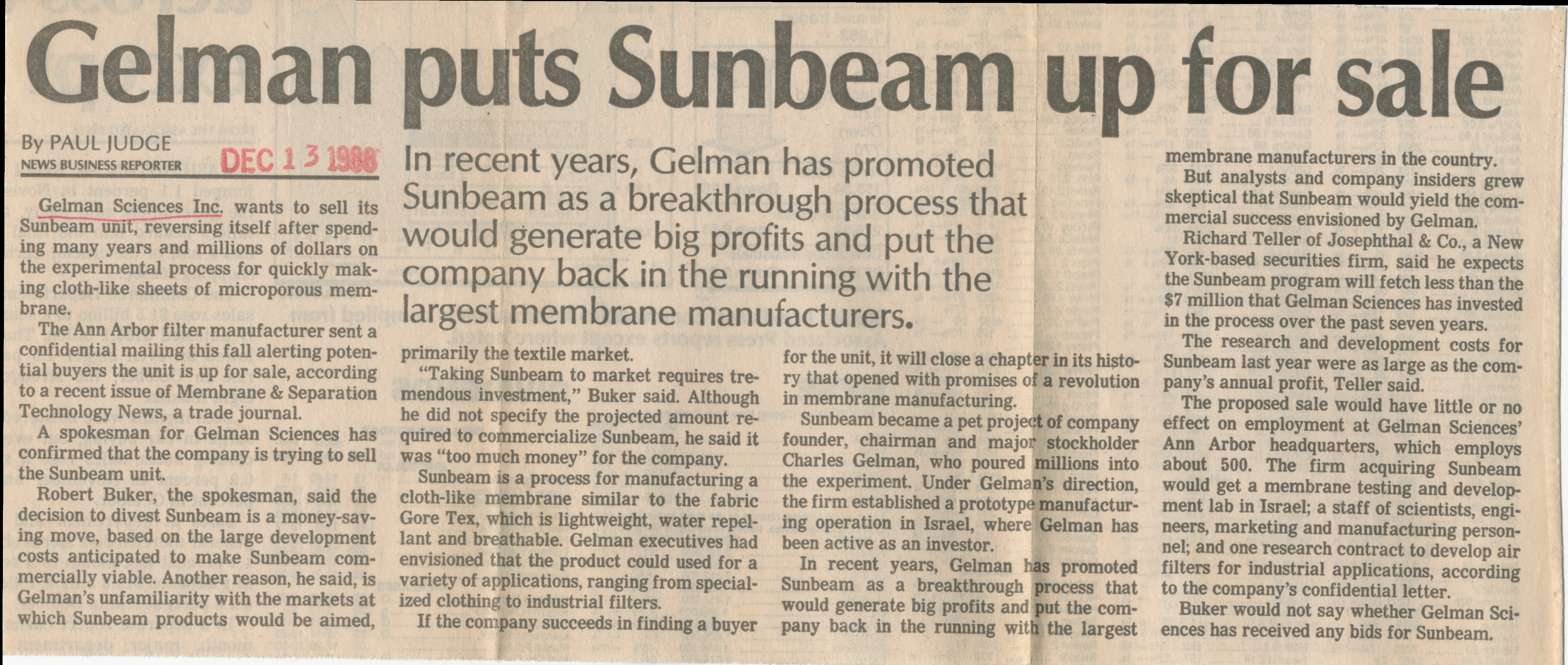Gelman Puts Sunbeam Up For Sale

Gelman puts Sunbeam up for sale
By PAUL JUDGE
NEWS BUSINESS REPORTER
Gelman Sciences Inc. wants to sell its SunBeam unit, reversing itself after spending many years and millions of dollars on the experimental process for quickly making cloth-like sheets of microporous membrane.
The Ann Arbor filter manufacturer sent a confidential mailing this fall alerting potential buyers the unit is up for sale, according to a recent issue of Membrane & Separation Technology News, a trade journal.
A spokesman for Gelman Sciences has confirmed that the company is trying to sell the Sunbeam unit.
Robert Buker, the spokesman, said the decision to divest Sunbeam is a money-saving move, based on the large development costs anticipated to make Sunbeam commercially viable. Another reason, he said, is Gelman’s unfamiliarity with the markets at which Sunbeam products would be aimed, primarily the textile market.
“Taking Sunbeam to market requires tremendous investment,” Buker said. Although he did not specify the projected amount required to commercialize Sunbeam, he said it was “too much money” for the company.
Sunbeam is a process for manufacturing a cloth-like membrane similar to the fabric Gore Tex, which is lightweight, water repellant and breathable. Gelman executives had envisioned that the product could be used for a variety of applications, ranging from specialized clothing to industrial filters.
If the company succeeds in finding a buyer for the unit, it will close a chapter in its history that opened with promises of a revolution in membrane manufacturing.
Sunbeam became a pet project of company founder, chairman and major stockholder Charles Gelman, who poured millions into the experiment. Under Gelman’s direction, the firm established a prototype manufacturing operation in Israel, where Gelman has been active as an investor.
In recent years, Gelman has promoted Sunbeam as a breakthrough process that would generate big profits and put the company back in the running with the largest membrane manufacturers in the country.
But analysts and company insiders grew skeptical that Sunbeam would yield the commercial success envisioned by Gelman.
Richard Teller of Josephthal & Co., a New York-based securities firm, said he expects the Sunbeam program will fetch less than the $7 million that Gelman Sciences has invested in the process over the past seven years.
The research and development costs for Sunbeam last year were as large as the company’s annual profit, Teller said.
The proposed sale would have little or no effect on employment at Gelman Sciences’ Ann Arbor headquarters, which employs about 500. The firm acquiring Sunbeam would get a membrane testing and development lab in Israel; a staff of scientists, engineers, marketing and manufacturing personnel; and one research contract to develop air filters for industrial applications, according to the company’s confidential letter.
Buker would not say whether Gelman Sciences has received any bids for Sunbeam.